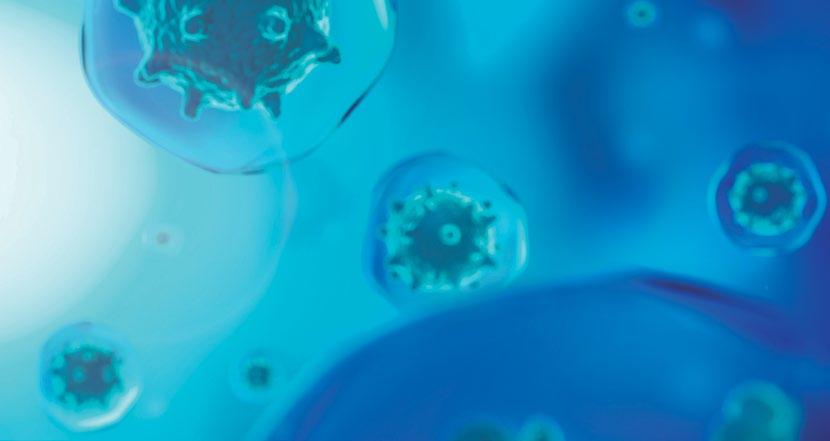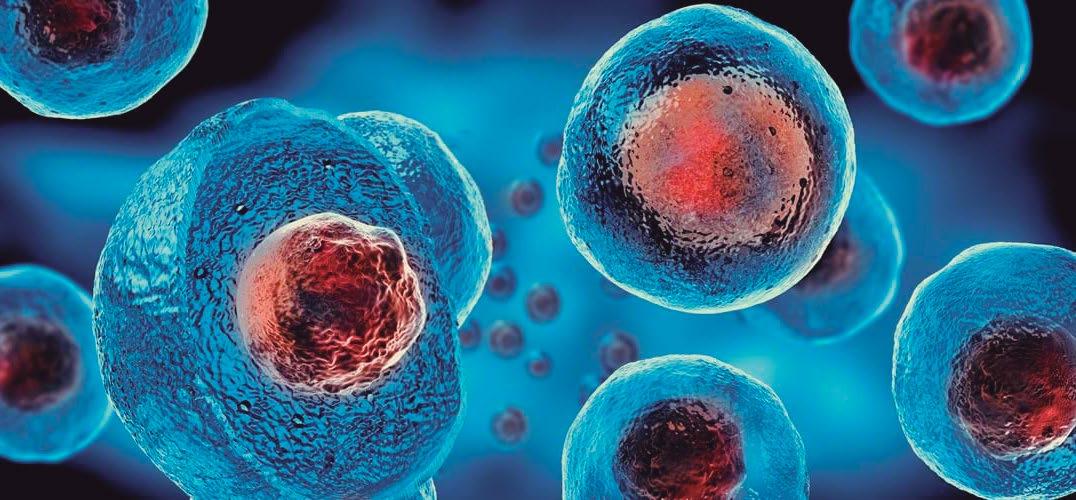
9 minute read
ANTIMICROBIAL RESISTANCE: THE GLOBAL THREAT OF THE FUTURE
An Interview with Aurora Escoto
Aurora Escoto holds an undergraduate degree in chemical pharmacobiology and a master’s degree in molecular biology from the Centro de Investigación Biomédica de Occidente (CIBO-IMSS), where she has worked on research into molecular biomarkers of breast cancer. She has also worked on the detection and expression of genes inserted into plasmids by means of end point PCR and real-time PCR and their transfection into eukaryotic cells, in order to produce proteins of interest to the pharmaceutical sector. She has collaborated on the design of a plasmid for the production of Interferon beta by means of Vector NTI Advance® 10 software, having received training for the purpose from NeuClone (Australian Technology Park), Sidney, Australia.
Advertisement
Aurora Escoto, antibiotics are a key element in scientific research. Could you tell us how exactly these medicines have been used?
Antibiotics can be divided into three classes, in accordance with their origin: so-called natural antibiotics (like penicillin), which are produced by microorganisms; semi-synthetic antibiotics, which are improved versions of natural antibiotics (e.g. ampicillin); and synthetic antibiotics, such as linezolid, which are manufactured in the laboratory.
The principal function of antibiotics is to inhibit the growth of (bacteriostatic agents) or to kill (bactericides) the pathogenic bacteria that are susceptible to them, so they are used to treat bacterial infections. Belonging to the latter of the two groups are the antibiotics β-lactam, aminoglycoside, rifampicin, vancomycin, polymyxin, fosfomycin, quinolone, and nitrofurantoin.
In order to be effective, antibiotics must penetrate the surface barrier of the bacteria. Antibiotics have been classified in accordance with their action mechanisms, which include the following: blocking the synthesis of the bacterial cell wall, inhibition of protein synthesis, inhibition of topoisomerase, inhibition of nucleic acid synthesis, damage to the deoxyribonucleic acid (DNA), damage to the synthesis of messenger rhibonucleic acid (mRNA), and the alteration of the cellular membrane of the bacteria on which they are acting.

We have information about infectious diseases and the bacteria most likely to cause them. For example, S. pneumoniae, H. influenzae, M. catarrhalis, and S. pyogenes have commonly been isolated in upper respiratory tract infections. Depending on his or her knowledge and experience, a doctor will prescribe an antibiotic of choice to eliminate infections of this kind.
One of the greatest challenges faced by modern science is the growing inefficacy of antibiotics. Drawing on your own experience, could you tell us what bacterial resistance is and how it is to be checked?
Bacterial resistance is the ability of a microorganism to avoid the effects of an antibiotic. The antibiotic is unable to kill the bacteria or inhibit its action, resulting in a failure of medical treatment. Bacterial resistance to a given antibiotic may be natural, as in cases when it appeared thousands of years ago and is identified in all the strains of its species. Gram-negative bacteria, for example, are impervious to the effect of penicillin G. Bacterial resistance can also be acquired, when bacteria that were formerly not resistant suddenly become so. This form of resistance poses a serious problem to medical science. It is generally produced through mutations and the transmission of extrasomic genetic material from other bacteria. If the transmission takes place from one generation to another, it is termed vertical; by contrast, horizontal transmission takes place through plasmids or other mobile genetic elements, such as integrons or transposons.
We mentioned above that there are several action mechanisms that prevent the growth and propagation of bacteria, but the bacteria find ways to avoid them, by means of the transfer of resistant genes.
There are bacteria that synthesize hydrolytic enzymes such as β-lactam, which inhibit the antimicrobial activity of different types of penicillin, cephalosporin, carbapenems, and monobactams. In order to neutralize these enzymes, the antibiotics use β-lactam inhibitors, such as clavulanic acid and sulbactam, which allow them to function. Another mechanism of bacterial resistance is the modification of the active site of the penicillin-binding protein (PBP). If a mutation is produced in the gap junction to the antimicrobial, it can no longer act and generate resistance. Likewise, mutation in the gap junction and ribosomal modification by means of erm genes modify the active site of the ribosome by methylation, causing inactivation. The diminishment of the permeability of the cell wall to the penetration of the antimicrobial is caused by changes in the diameter or number of the porins, which can block the entry of the antimicrobial into the bacteria. This is the main form of natural resistance. Efflux pumps transport the antibiotic toward the exterior of the bacteria, preventing it from exercising its antimicrobial function.
The most important measure recommended to healthcare providers by the World Health Organization (WHO) in order to check the progress of resistance to antibiotics is simply not to prescribe antibiotics unless they are actually necessary. It is estimated that half of the ailments for which they are prescribed are of viral origin, against which they are ineffective.
If a doctor has prescribed antibiotics, the course of treatment should be followed to the end. Not doing so fosters the development of drug-resistant bacteria. In the case of veterinary use, take should be taken that the antibiotics are solely for the control and treatment of infectious diseases, since the improper use of antibiotics in animals raised for human consumption is a central factor in the propagation of resistance to antibiotics among humans. Finally, the lack of clean water and hygiene and the inadequate prevention and control of infections fosters the propagation of bacteria, some of which may be resistant to treatments through antibiotics.
Are these resistance mechanisms transmitted from one type of bacteria to another?
Yes. The horizontal transfer of resistant genes has been observed in both gram-positive and gram-negative bacteria. One of the horizontal mechanisms is transformation, which allows the introduction of naked DNA. When the bacteria die and their membrane has been more or less destroyed, the fragments can be captured by other bacteria. This form of resistance has been described in gram-negative bacteria belonging to the genera Acinetobacter, Campylobacter, Haemophilus, and Neisseria and in some grampositive bacteria of the genera Bacillus and Streptococcus. This mechanism allows bacteria that are very distant from one another on the phylogenetic plane to share information, since it is universal in nature and can be assimilated by any bacteria. The mechanism of conjugation also plays an important role, but is likely to be more effective when there are fewer genetic differences between the bacteria. Even so, transfers of resistant genes have been observed between gram-positive and gram-negative bacteria. Most of the genes transferred are situated in mobile genetic structures such as plasmids or transposons. These last are DNA sequences that may contain genes resistant to antibiotics: they are able to move and integrate themselves into another location of the genome, acting as jumping genes. Transposons not only allow transmission over generations, but also to other species of bacteria. These may thus acquire resistance to one or several antibiotics without ever actually having been in contact with them.
Can the same bacteria be resistant to several different antibiotics?
Yes, in the case of the horizontal transmission of resistant genes, conjugation plays a role in DNA sequencing that carries genes resistant to antibiotics or transposons, which, by integrating themselves into the plasmids, make it possible for the bacteria to contain genes resistant to five or six different families of antibiotics, so that they become “multi-resistant.” These gene elements have their own recombination system, which allows for the aleatory interchange of non-homologous DNA end joining, whereby the resistant genes are inserted into the chromosome.
How do you imagine human and animal life in the not too distant future, if recommendations for the proper use of antibiotics are not followed?
We are currently seeing an increase in resistance to antibiotics that can be considered a global health concern. If we continue to ignore recommendations regarding their proper use and their abuse, the time will come when bacteria will no longer be susceptible to the effects of antibiotics. We will then require more aggressive and more toxic drugs in order to eliminate bacteria.
Some super-bacteria are already showing resistance to powerful antibiotics of the latest generation. It is estimated that some 700,000 people die worldwide every year because of antimicrobial resistance, and that this figure could increase to 10 million by the year 2050.
What, in your view, are the greatest challenges facing public health officials and clinical researchers in 2021?
Bacteriological research in recent years has demonstrated the rapid progression of bacterial resistance to antibiotics. Every time a new antibiotic is used, bacteria have adapted to it with increasing speed, generally needing only two to four years to develop new defense mechanisms. It is therefore important to continue developing new antibiotics, as well as detecting individual instances of resistance, and the appropriate treatments in each case. Cyclical rotation of antibiotics in health clinics is recommended, in order to reduce resistance. We also need national and international monitoring of antimicrobial resistance, whereby the improper use of antibiotics is controlled, not only among doctors and health professionals, but among others who freely dispense them. It is necessary to research the way the transmission of resistance is taking place, as well as to examine the causes and consequences of the development of resistance. Finally, it is indispensable that pharmaceutical companies create new vaccines and that these actually be used by the people who need them.
Bibliography
1. See Gonzalo López Sánchez, “Penicilina, el antibiótico que revolucionó la medicina,” ABC Ciencia (1 November 2020): <https://www.abc.es/ciencia/20150311/abci-penicilinafleming-antibiotico-201503101345.html> 2. Vicente Ortega and M. Ángeles Maya, “La Penicilina y la Segunda Guerra Mundial,” Cátedra Isdefe-UPM: <http://catedraisdefe.etsit.upm.es/wiki/index.php/La_ Penicilina_y_la_Segunda_Guerra_Mundial> 3. F. Paredes, “Acción de los Antibióticos. Perspectiva de la medicación antimicrobiana,” OFFARM, vol. 23, no. 3 (March 2004). 4. Ibid.; and A. Perdomo, “Estudio de uso de antibióticos en medicina interna del Hospital General de Chimalhuacán, Estado de México,” thesis (Universidad Nacional Autónoma de México), 2014. 5. A. Pascual Hernández et al. (eds.), Actualización en antimicrobianos (Barcelona: Ediciones Doyma. 2004). 6. S. Martin-Aragón, “Infecciones de las vías respiratorias altas,” OFFARM, vol. 29, no. 6 (November-December 2010). 7 J. Oromí Durich, “Resistencia bacteriana a los antibióticos,” Medicina Integral, vol. 36, no. 10 (December 2000), pp. 367-370: <https://www.elsevier.es/es-revistamedicina-integral-63-articulo-resistencia-bacterianaantibioticos-10022180> 8. Ibid. 9. Ibid. 10. Antimicrobial resistance: Tackling a crisis for the health and wealth of nations, The Review on Antimicrobial Resistance Chaired by Jim O’Neill (December 2014).








